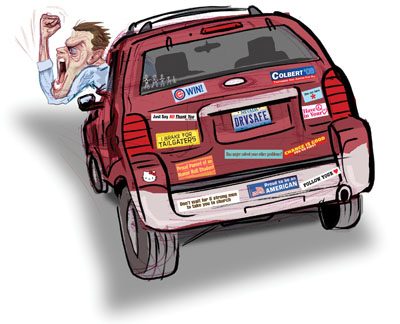Bumper stickers may lead to bumper cars
We've all been victims of a screamed curse word or flipped bird or honked horn.
In my experience, such salutations are part of driving in a big city.
It's called road rage.
While most drivers are quick to forgive, some aren't. But there might be an easy way to spot the most aggressive road ragers: bumper stickers.
And it's not just bumper stickers that read, "Driver carries no less than 20 lbs of ammo" or "Some people are only alive because it's illegal to shoot them."
It's all bumper stickers, including, "Give peace a chance," "Free Tibet," or "My boss is a Jewish carpenter."
That's what a recent study by William Szlemko and colleagues at Colorado State University concluded.
Szlemko argues that people who put bumper stickers, decals or personalized plates on their vehicles are most likely to act aggressively toward other drivers.
The social psychologist calls bumper stickers territorial markers, which signal that drivers view their space on the road as their personal area, similar to a home, and not as a public area to be shared. As a result, they defend their "territory" more aggressively.
"Mere presence of a territory marker predicts increased use of the vehicle to express anger and decreased use of adaptive/constructive expressions," according to Szlemko's paper published in this month's issue of Journal of Applied Social Psychology.
Wow. That's some easy reading. Obviously, they're not paying Szlemko to write bumper stickers. (By the way, I still haven't figured out what the heck "adaptive/constructive expressions" means).
Szlemko acknowledges that drivers who are not in personalized vehicles also get angry at other motorists. They just don't react with such rage or vigor.
Szlemko and his fellow researchers tested the theory by sitting in a car at a traffic light long after it changed from red to green and blocking traffic, according to a Washington Post report. Drivers with bumper stickers were a full two seconds quicker to honk their horn than those motorists without them, they found.
I wonder if Szlemko would get the same reaction here in Las Vegas.
Capt. Richard Collins, head of the Metropolitan Police Department's traffic bureau, told me he was unaware of the "bumper sticker" theory, but said road rage is a bigger problem here than it should be.
"The road rage that we see, other than shootings, usually will begin when someone cuts another driver off," Collins said.
That starts a chain of events.
First the driver gets mad that it happened to them and then that there are no police officers around to write a ticket to the driver who cut them off, Collins said.
"The so-called offended party then becomes the aggressor and will do things like tailgate, speed up and slow down, pull up next to the offender and flip them off or even pull in front of the offender and slow down or stop to show the offender that they did something wrong," he said.
A combination of those things can lead to wrecks and arrests.
State law has an aggressive driving statute meant to curb road rage. NRS 484.3765 is a misdemeanor and the first offense can cost you $1,000 in fines and six months in jail.
"If drivers would be more courteous, then we could avoid many tickets, damaged vehicles, arrests and lawsuits," Collins said.
Szlemko's hypothesis might be right, but it would be difficult to put into practice on our freeways. On some valley freeways, cutting off other motorists is a necessary evil, especially with the short merge lanes on Interstate 15.
The problem is that motorists can't tell if the vehicle they are getting in front of has a "Globalize Peace" message stuck to the rear bumper.
But it's still probably good advice to avoid ticking off someone with a bumper sticker that reads: "Gun control means using both hands."
If you have a question, tip or tirade, call the Road Warrior at 387-2904, or e-mail him at roadwarrior@reviewjournal.com or fmccabe@reviewjournal.com. Please include your phone number.
The Las Vegas Beltway will be reduced to one lane in each direction as it passes over south Decatur Boulevard from 9 p.m. Thursday through 5 a.m. July 8, the Clark County Public Works Department announced. Motorists should also note the eastbound onramp from Decatur and the westbound offramp will be closed at that time. The lane restrictions and ramp closures are the result of ongoing work to widen the Beltway overpass at Decatur.
Power line work being done on Las Vegas Boulevard at Searles Avenue is expected to wrap up on Saturday, the Las Vegas Public Works Department announced.
Repairs to the Laughlin-Bullhead City Bridge will begin July 7, the Nevada Department of Transportation announced. During the 15-day project, the eastbound lane closest to the pedestrian access will be closed. Work will be done Sundays through Thursdays from 7 p.m. to 6 a.m. the following day.
REVIEW-JOURNAL






















